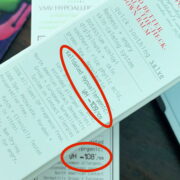Not An Allergen
Covid-19 Vaccines
As of the time of this writing and the information available, none of the Covid-19 vaccines are known contact allergens or contain multiple contact allergens in their ingredients. Even if they were, the chances of a skin reaction would be unlikely as the vaccines are injected, not applied topically on the skin. That said, work closely with your allergist if an ingredient that you prick tested positive for is in a concern. They will provide you with the best guidance. For more on the difference between skin and other types of allergic reactions: see Skin & Food Allergies Are Not The Same Thing.
For a reliable resource on the ingredients that tend to be in the COVID-19 vaccines, visit “How Vaccines Are Developed” at the World Health Organization website.
Some ingredient information:
Pfizer Vaccine Ingredients:
messenger ribonucleic acid (mRNA), lipids (4-hydroxybutyl)azanediyl) bis (hexane-6,1-diyl) bis (2-hexyldecanoate), 2 [(polyethylene glycol)-2000]-N, N-ditetradecylacetamide, 1,2-Distearoyl-sn-glycero-3-phosphocholine, and cholesterol), potassium chloride, monobasic potassium phosphate, sodium chloride, dibasic sodium phosphate dihydrate, and sucrose.
Moderna Vaccine Ingredients:
messenger ribonucleic acid (mRNA), lipids (SM-102, polyethylene glycol [PEG] 2000 dimyristoyl glycerol [DMG], cholesterol, and 1,2-distearoyl-sn-glycero-3-phosphocholine [DSPC]), tromethamine, tromethamine hydrochloride, acetic acid, sodium acetate, and sucrose.
AstraZeneca Vaccine Ingredients:
Recombinant, replication-deficient chimpanzee adenovirus vector, Histidine, Histidine hydrochloride monohydrate, Sodium chloride, Magnesium chloride hexahydrate, Disodium edetate (EDTA), Sucrose, Ethanol absolute, Polysorbate 80, Water.
Sinovac (Coronavac) Vaccine Ingredients:
inactivated SARS-CoV-2 Virus (CZ02 strain), aluminum hydroxide, disodium hydrogen phosphate dodecahydrate, sodium dihydrogen phosphate monohydrate, and sodium chloride.
Resources:
- “What Ingredients are in the Covid-19 Vaccine?” on the Connecticut Department of Public Health website.
- “Report on Evaluation of Safety, Efficacy and Quality of CoronaVac COVID-19 Vaccine (Vero Cell) Inactivated” on the Hong Kong Food and Health Bureau.
IMPORTANT: It is important to emphasize that this information is accurate to our knowledge as of this writing. Follow your doctor’s instructions and rely on trusted sources such as the World Health Organization, Centers for Disease Control and Prevention, and your country’s department of health.
AS ALWAYS, please consult with your doctor (allergist, dermatologist, or other medical practitioner) if you have concerns regarding COVID-19 vaccines and your skin or other allergies, your use of biologics or other medication, and/or your other health conditions.
If you have a history of sensitive skin…
…don’t guess! Random trial and error can cause more damage. Ask your dermatologist about a patch test.
To shop our selection of hypoallergenic products, visit vmvhypoallergenics.com. Need help? Ask us in the comments section below, or for more privacy (such as when asking us to customize recommendations for you based on your patch test results) contact us by email, or drop us a private message on Facebook.
For more:
- On the prevalence of skin allergies, see Skin Allergies Are More Common Than Ever.
- For the difference between irritant and allergic reactions, see It’s Complicated: Allergic Versus Irritant Reaction.
- For the difference between food, skin, and other types of reactions: see Skin & Food Allergies Are Not The Same Thing.
- On the differences between hypoallergenic, natural, and organic, check out Is Natural Hypoallergenic? and this video in our YouTube channel.
- To learn about the VH-Rating System and hypoallergenicity: What Is The Validated Hypoallergenic Rating System?
Main References:
Regularly published reports on the most common allergens by the North American Contact Dermatitis Group and European Surveillance System on Contact Allergies (based on over 28,000 patch test results, combined), plus other studies. Remember, we are all individuals — just because an ingredient is not on the most common allergen lists does not mean you cannot be sensitive to it, or that it will not become an allergen. These references, being based on so many patch test results, are a good basis but it is always best to get a patch test yourself.
1. Warshaw, E.M., Maibach, H.I., Taylor, J.S., et al. North American contact dermatitis group patch test results: 2011-2012. Dermatitis. 2015; 26: 49-59.
2. W Uter et al. The European Baseline Series in 10 European Countries, 2005/2006–Results of the European Surveillance System on Contact Allergies (ESSCA). Contact Dermatitis 61 (1), 31-38.7 2009.
3. Wetter, DA et al. Results of patch testing to personal care product allergens in a standard series and a supplemental cosmetic series: An analysis of 945 patients from the Mayo Clinic Contact Dermatitis Group, 2000-2007. J Am Acad Dermatol. 2010 Nov;63(5):789-98.
4. Verallo-Rowell VM. The validated hypoallergenic cosmetics rating system: its 30-year evolution and effect on the prevalence of cosmetic reactions. Dermatitis 2011 Apr; 22(2):80-97.
5. Ruby Pawankar et al. World Health Organization. White Book on Allergy 2011-2012 Executive Summary.
6. Misery L et al. Sensitive skin in the American population: prevalence, clinical data, and role of the dermatologist. Int J Dermatol. 2011 Aug;50(8):961-7.
7. Warshaw EM1, Maibach HI, Taylor JS, Sasseville D, DeKoven JG, Zirwas MJ, Fransway AF, Mathias CG, Zug KA, DeLeo VA, Fowler JF Jr, Marks JG, Pratt MD, Storrs FJ, Belsito DV. North American contact dermatitis group patch test results: 2011-2012.Dermatitis. 2015 Jan-Feb;26(1):49-59.
8. Warshaw, E et al. Allergic patch test reactions associated with cosmetics: Retrospective analysis of cross-sectional data from the North American Contact Dermatitis Group, 2001-2004. J AmAcadDermatol 2009;60:23-38.
9. Foliaki S et al. Antibiotic use in infancy and symptoms of asthma, rhinoconjunctivitis, and eczema in children 6 and 7 years old: International Study of Asthma and Allergies in Childhood Phase III. J Allergy Clin Immunol. 2009 Nov;124(5):982-9.
10. Kei EF et al. Role of the gut microbiota in defining human health. Expert Rev Anti Infect Ther. 2010 Apr; 8(4): 435–454.
11. Thavagnanam S et al. A meta-analysis of the association between Caesarean section and childhood asthma. Clin Exp Allergy. 2008;38(4):629–633.
12. Marks JG, Belsito DV, DeLeo VA, et al. North American Contact Dermatitis Group patch-test results, 1998 to 2000. Am J Contact Dermat. 2003;14(2):59-62.
13. Warshaw EM, Belsito DV, Taylor JS, et al. North American Contact Dermatitis Group patch test results: 2009 to 2010. Dermatitis. 2013;24(2):50-99.
14. Verallo-Rowell V. M, Katalbas S.S. & Pangasinan J. P. Natural (Mineral, Vegetable, Coconut, Essential) Oils and Contact Dermatitis. Curr Allergy Asthma Rep 16,51 (2016) . https://doi.org/10.1007/s11882-016-0630-9.
Want more great information on contact dermatitis? Check out the American Contact Dermatitis Society, Dermnet New Zealand, and your country’s contact dermatitis association.
Laura is our “dew”-good CEO at VMV Hypoallergenics and eldest daughter of VMV’s founding dermatologist-dermatopathologist. She has two children, Madison and Gavin, and works at VMV with her sister CC and husband Juan Pablo (Madison and Gavin frequently volunteer their “usage testing” services). In addition to saving the world’s skin, Laura is passionate about health, inclusion, cultural theory, human rights, happiness, and spreading (like a VMV cream!) goodness!









[…] found in medical preparations such as opthalmogic ointments, topical pharmaceutical medications, vaccines, prick test allergens, immunoglobulins, and antitoxins. It was also used as a preservative in […]
[…] Different types of aluminum salts may elicit more or less contact reactions. Note that COVID-19 vaccines do not contain aluminum as an […]